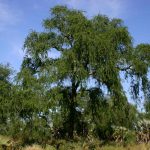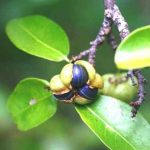TREE LIFE 133
MARCH 1991
Our New Year is upon us again and subs are due. Please send your crossed $15 cheque or Postal Order to The Treasurer, Tree Society of Zimbabwe, P.O. Box 2128, Harare before 1st April.
MASHONALAND CALENDAR
Tuesday 5th March: Botanic Garden walk with Tom Muller. Park your car at the Herbarium where we will meet Tom at 1645 hours 1700 hours.
Sunday 17th March: Trevor and May Gordon have years of experience in growing indigenous trees, in fact Trevor has planted many species on the Kopje near his house and this is one of the areas he going to show us on Sunday. All except our new members will know that Trevor is an authority on indigenous trees so we are really lucky to be able to spend the day with him and May.
Saturday 23rd March: walk with Mark in the Mukuvisi Woodland meeting in the main car park at 1500 hours
Easter Week-end – See Matabeleland calendar
MATABELELAND CALENDAR
Sunday, 3rd March: We go to Mr Roy Stephens‘ Shumba Shave Mkulu, on the fringes of the Matopos, a fabulous area, (last time we saw 120 species). We are promised new walks. Bring a really PORTABLE LUNCH, as it will be a long hike for those able. An all-day outing. Meet at Retreat, 8.30 a.m. It will be about 50 km from there.
Wednesday, 13th March: It has been suggested that we have an evening botanical walk at Hillside Dams. Ian McCausland will lead, with the idea of learning 5 trees and studying grasses, wild flowers etc. Meet at the Aloe Garden, by 5.00 p.m. Home before dark.
Sunday, 17th March: Back to Richmond Nature Park, (near the lower Umgusa Dam), where the first stage development is taking place, and to finish off a Tree-List for use in the area. Meet at Falls Road Motors, 8.30 a.m. Morning only – bring tea, chairs and binocs.
Friday, 29th March EASTER WEEK-END: Arrangements have been made for about 30 people to be housed in and around Bon Accord Farmstead. About 12 can be accommodated on own beds in 3 bedrooms/lounge. A large veranda can also be used, plus tents, around the security-fenced garden. That is to save being trampled on by giraffe/kudu/sable/tsessebe/impala etc. of the Game Reserve – very close to Naletale Ruins, a spectacular place. Ablutions are a bit spartan, but might be improved. About 30 km East of Shangani, on a first come, first served basis. Neighbouring farmers will probably offer accommodation also. Phone Ken Blake on Bulawayo 61384 or Maureen Silva Jones on Harare 739711 (both office numbers) to book.
MATABELELAND NOTES
On Sunday, February 3rd, we went to Whitestone School, empty, being a Holiday weekend. we much enjoyed the excellent variety of indigenous trees, close in and around the buildings and courtyard in particular, we found some 78 species. We also used our New Bulawayo District Field Cards, for the first time, and found them very good.
Of note were 4 Acacias – A. gerrardii, A. karroo, A. rehmanniana, A. sieberiana, Albizia antunesiana, leaves very purple,
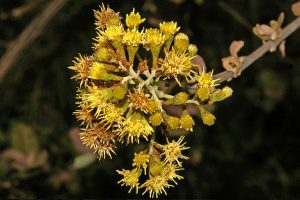
Brachylaena discolor. var rotundata. Photo: Meg Coates Palgrave. Source: Flora of Zimbabwe
Brachylaena rotundata, Canthium lactescens, Catha edulis, Cissus cornifolia, Clerodendrum myricoides, Commiphora africana, Cussonia natalensis, Dodonaea angustifolia, Dovyalis zeyheri, Faurea saligna; Ficus glumosa, F. sur, F.thonningii, Flacourtia indica fruiting, Maytenus heterophylla, M. senegalensis, Ormocarpum trichocarpum, Ozoroa insignis, subsp- reticulatum, Pappea capensis, Parinari curatellifolia, Pavetta schumanniana, Piliostigma thonningii, Psydrax livida, Pterocarpus angolensis, Schrebera alata, Sericanthe andongensis, Strychnos madagascariensis, Terminalia sericea, T. trichopoda, Tetradenia brevispicata, Turraea nilotica, Vangueria randii ; fruiting, Vitex payos, Zanthoxylum capense altogether a fine collection for school—children to start on. Hopefully this is the case. Charles Sykes
Our extra February outing to Val Deas’ neighbourhood in Matsheumhlope didn’t produce many members, probably due to the inclement weather, but certainly the trees were on our side with 82 species in two and a half hours. In fear and trepidation we set off with the warning from Val ringing in our ears, “Don’t look at trees for the first 1.5km!” and then we reached a spot near the foot of a kopje where we started counting. Not having Charles Sykes with us, I filled in a card, and here an apology is necessary. Normally I harass him for being so slow, but it is a job and a half. Sorry Charles! Val came up with a few surprises –
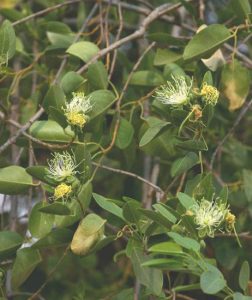
Maerua angolensis. Photo: Bart Wursten. Source: Flora of Zimbabwe.
Maerua angolensis (the bead bean tree) which is not often seen; Steganotaenia araliacea, normally only found in Matopos as a “pop—gun” tree, but as Geoff Archer has suddenly discovered it is also known as the”carrot” tree as all parts smell like raw carrots – and was demonstrated. Maytenus undata another unusual; Rhus tenuinervis very different from R. pyroides which was also seen; several Schrebera alata also not usually seen so close to Bulawayo; Sericanthe andongensis another rarity; and the one Meg identified in that area many years ago, the Tapiphyllum velutinum; both Ximenia caffra and X. americana showing the great leaf differences. Among the usual Acacias, A. gerrardii, A. nilotica, A. rehmanniana, we found A. robusta subs. robusta and Albert Lehuray positively identified A. karroo. Ken Blake melted at the sight of Ormocarpum trichocarpum (the hairy caterpillar tree) and Wendy Bullock found the Croton gratissimus very reminiscent of Matopos, while we crowded around Betty Blake with the only Ficus of the day, F. glumosa. Both the sweet smelling Lippia javanica and L. oatesii were there, as was the shrubby Acacia chariessa.
A new idea, with possibilities, was tried out – each member was issued with a couple of cards with diagrams of leaf shapes and names, and during the outing was asked to identify from which trees – it kept everybody on their toes!
Thank you Val for an excellent and exciting outing – we will be back!
-KEN BLAKE.
BOTANIC GARDEN WALK : THE BURSERACEAE
Whenever we find a compound leaf that has an end leaflet bells ring in our brain, we immediately see if all three and leaflets emerge from one point or if the midrib of the leaf extends beyond the last pair of leaflets before it attaches to the end leaflet. If the midrib extends like this then the tree is probably a legume in the pea Family, FABACEAE (the old Papilionoidae). If this ‘pulvinus’ is absent then the tree belongs to the large order, the Sapindales. we usually say that the Sapindales extend from Psalms to Malachi, because in the tree book they extend from a few pages before the colour plates to two thirds of the way through the book. Families in the Sapindales include the BURSERACEAE (eg. Commiphora), MELIACEAE (eg Khaya), ANACARDIACEAE (eg. the marula), MELIANTHACEAE (eg. Bersama), SIMAROUBACEAE (eg Kirkia) and RUTACEAE (eg Zanthoxylum). This month we looked at the BURSERACEAE.
The BURSERACEAE are most at home in hot, dry habitats such as the S.E. Lowveld and Zambezi Valley and are generally characterized by resins in the bark. Some of these resins are aromatic and include myrrh, frankincense and the balsam of Gilead which have been collected for many centuries from plants in the hot Middle East. During the walk we slashed a number of Tom’s specimens and saw the bright red under bark, as we watched the resin oozing out slowly I always recall images of the Shulammite maiden from the Song of Solomon:
ACT 1, SCENE 1 : The inner chamber belonging to said maiden, sun is setting.
ENTER: One Shulamite maiden with hair like “a drove of goats that have hopped down from the mountainous region of Gilead” and teeth like freshly-shorn ewes (each bearing twins) that have gone up from the washing (Canticles 4:l&2).
ACTION: Maiden begins to smear herself with the sticky liquid myrrh and retires to bed.
SCENE 2 (a few hours later): Loud rapping heard off stage. Maiden awakes and rises from the bed dripping with myrrh to such an extent that she leaves door latch covered with the stuff‘ (Ca.5:2-5).
ENTER: One shepherd-lover easily identified because his lips drip with liquid myrrh (Ca.5:l3).
TACTFUL ASIDE: This commercial break informs you that given time this gummy exudate hardens into lumps that can be chipped off and sold by Ishmaelite traders just like those who bought Joseph and took him to Egypt (Genesis 37:28).
BACK TO THE STORY: Goat-like hair spread over pillow and lover clutched to her breasts just like a lumpy bag of myrrh (Ca.l:l3).
ACT 2, SCENE l (A few centuries later): The botanic gardens, in far away Harare.
EXIT: Shulammite maid and shepherd-lover leaving only gummy aromatic resins oozing out of Commiphora trees. The original myrrh may have come from a number of species of Commiphora including C. myrrha and C. abysinica which grow in the rocky limestone hills in the Middle East. We tried out most of the indigenous resins and found a number that were suitably aromatic, but all somewhat spicy more like an after shave than a perfume. Prof. Wild stated that the genus was “leafless for the greater part of the year” and so we need to resort to using the bark and the presence or absence of spines. Of the 15 species of Commiphora in Zimbabwe, 6 have spine-tipped branches and one species (C. mollis) sometimes has spines. The spiny species are more confusing than the others so let’s finish with them first. They include C. ugogensis, C. schimperi, C. africana, C. glandulosa (previously called C. pyracanthoides , C. viminea a damnable new name for C. merkeri), and C. neglecta .
The last time I wrote up the BURSERACEAE was in January 1986. I find it interesting to see what I have learned in five years. I stated than that C. ugogensis looked confusingly like C. africana. This is not so in the field, C. ugogensis is a most distinct tree with a rich brown peeling bark. Although it has a green under bark this does not interfere with the overall impression of the tree so it cannot be confused with C. africana which is green. Small groves of
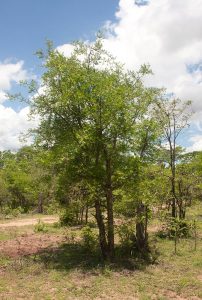
Commiphora ugogensis. Photo: Bart Wursten. Source: Flora of Zimbabwe.
Commiphora ugogensis occur between Mana Pools and Chikwenya. It is also common around the edges of some jesse vegetation close to where the Manyame River enters Mozambique. Tom and I had a spectacular view of these trees from a helicopter last year. C. schimperi and C. africana have similar barks and both have trifoliolate leaves, but the leaflets on C. africana are hairy whereas those on C. schimperi are smooth. We examined the fruit of C. schimperi in greater detail. In most species the black seed is partly surrounded by a red aril. But when Pamela examined the seeds of C. schimperi she announced to us all that the aril completely surrounded the seed. Phil found the same. In reality they were right, this is one species with a complete aril! This species is confined to lower altitudes. C. africana grows nearby in the gardens. There are two forms of this species, the taller one that we are all familiar with, and a second shorter tree that seldom exceeds a metre in height and is confined to mopane vegetation. We saw the other spiny species over in the S.E. Lowveld section of the gardens. The taxonomy of C. glandulosa has changed in recent years. Whereas all specimens in Zimbabwe were called C. pyracanthoides, now there is a division between the shrub-like C. pyracanthoides that grows in the Limpopo Valley, and the tree-like C. glandulosa, which—has a glandular calyx and often grows in Kalahari Sand. We had a brief look at C. viminea with its zebra stripes. Tom’s C. neglecta is hidden away close to the Monodora. I have never seen a wild specimen, but apparently they grow around Chisambanje along with Teclea murii and also occur in Gonarezhou (Tom thinks that we saw them with the Tree Society, but my memory is a bit blurred). Tom’s specimen was grown from seed collected near Maputo.
Moving on to the non-spiny species: I once thought that C. mollis and C. karibensis were remarkably similar, and Tom’s two specimens that grow side by side in the gardens are enough to confuse anyone. In the last newsletter I stated that Colin Craig said he had no trouble telling them apart, naturally at the time I did not quite believe either him or Tom. But having seen many specimens now I must agree. Sometimes C. mollis is so different that there is no similarity at all, it is often not very twisted and the main trunk may loose all the toffee like wrinkles. It does help to know that C. karibensis is generally confined to jesse thickets. It is usually very fluted and often damaged by elephant. We retested the hypothesis that the two species have different resins, and it worked again: in C. mollis the resin is distinctly milky white, but in C. karibensis it is more translucent.
The first tree that we had examined on the walk was C. zanzibarica, one that I have not seen in the wild. It has larger leaflets than most of the other indigenous species and grows along dry river courses near the Save River south of Birchenough Bridge, and also towards the lower Mazowe River in the Mudzi area. It is the only species in the gardens that has a pale yellow sap, but as our sample size is one we do not know how relevant this is. The bark looks least like a Commiphora. Later on we looked at C. edulis which we were most excited to find in Kariba on the last Tree Society visit. C. mossambicensis has distinctive honey-coloured trunk and is easily identified on the roadsides along the Zambesi Escarpment. Jonathan Timberlake says it grows as a weed after fire or other disturbance of woodland on Kalahari Sand. Each leaflet resembles the leaf of an apricot, and smells peppery when crushed, it is the easiest species to identify on smell alone. There are three paper bark species that have very large peels. In C. caerulea the under bark is distinctly cerulean (sky-blue), whereas in C. marlothii the under bark is bright green. Just as an aside some of us may remember the interesting outing to the AGM of the Ayrshire branch, when we climbed up the kopje on the Duffield’s farm and found a member of the LORANTHACEAE that I have only ever seen on this species. It droops down from the branches in an unusual manner. In the Commiphora section we also found C. angolensis which grows on Kalahari Sands. Near the end of the walk we found C. tenuipetiolata. Five years ago I stated that the specimen was too small to see the flaky bark, well now it is a decent size, it reminded us of those specimens that we saw in Tuli where it grows with Sesamnothamnus and has delicate leaves that hang down.
We finished the walk by looking at Boswellia carteri which Tom grew from seed sent out from Cuba. This species is used to harvest frankincense. Frank simply refers to high quality and the resultant incense was highly praised in biblical times. This little tree grows in a bed to the left of the herbarium, west of the large Markhamia obtusifolia. We must thank Tom for yet another entertaining sundown seminar.
Kim Damstra.
MUKUVISI WOODLAND NOTES
When we went to the Mazowe at Chipoli last year we looked at some dead wood still standing which may have been a remnant of severe damage from the big frost of 1968. At first sight for deadwood to stand for twenty two years seems improbable, however there is a dead Burkea africana still standing quite strong in the Mukuvisi Woodland, and this tree was ring barked by vandal in mid-winter 1979. However, I digress, the dead wood along the Mazowe caused us to talk about the big frost of ’68 and I subsequently asked if any readers could provide any anecdotes about this natural phenomena.
Peggy Izzett has now given me some notes of her personal observations at that time :
NOTES ON THE BIG FROST CF 13.6.1968
These notes were made on trees on and adjacent to Muunzi smallholding at the end of Stoneridge Road, turning off the Beatrice Road at the 8 mile peg. The area is on granite sandveld, and the water supply is about 20 feet below the surface. Granite outcrops occur on Muunzi. The tree growth in the area is good and there are many large msasa trees. The land lies a quarter of a mile from the Hunyani River on the west bank. (Since 1968 a bridge has been built over the river leading to Chitungwiza).
Notes in May 1968: During the month sprays of leaves began to turn yellow on Pterocarpus angolensis, Burkea africana and Monotes, as usual. Brachystegia very green, the weather has been warm up to the end of the month. The last rain was in April. No sign of frost yet.
Notes in June 1968: On the night of 13th there was, without any warning, a terrible frost. The verandah thermometer, facing south, at 6.30 am read 34 degrees Fahrenheit. Much damage had evidently been done to trees, but the full extent became visible after three days. The temperatures at night on the 14th 15th and 16th were all below freezing.
Once the leaves had begun to dry one could see how terrible was the damage. The only tree which appeared to have withstood the frost were the Faurea saligna and even on some of them some of the leaves were shriveled, everything else, even up to the top of the largest msasa looked as though they had been in a fire, except that the leaves were still there. Occasionally one found a small shrub which had been sheltered by the larger trees and had not suffered so much damage. On the whole, however, the general appearance of the bush was the colouring of brown and grey. One could snap a twig off, with its dead leaves, and work back along the branch until the wood was as thick as one’s finger, and the material was still dead.
August 1968: During the first week of August, a few sprays of new leaves had begun to appear on a medium sized msasa in the garden. The new leaves stood out amongst the dead foliage – it was very noticeable that the dead leaves did not fall from the trees, mostly clinging tenaciously to the dead twigs, particularly on the msasas. I suppose that being killed suddenly by the frost, together with the twigs and branches in many cases, there was no operation of the normal leaf drop mechanism.
By the end of August, as the weather began to warm up slightly more new leaves began to appear, all very pale, and scattered in bunches here and there on the trees particularly the msasas where the new growth often came out from the main trunk directly. The uppermost branches of the tall trees were in most cases completely dead, and later I noted that it took almost three years for this dead wood to disappear and then not all of it vanished.
I cannot say that the following happened to all the frozen trees, but I saw it on the msasa, because they were before my eyes always around the garden. The trees put out long shoots, a metre or more in length, and often from the main trunk of the tree, with huge leaflets on them. These shoots were actually gigantic twigs and they hung weeping willow fashion, making the trees look quite unlike their normal selves. I measured one leaflet and it was 14 cm in length. Flower buds did appear on these twigs but there was not a very good crop of pods. This growth was an impressive demonstration of natures resources for survival.
Another casualty, though not among the trees, was the cocoons of the large moth which lays its eggs on the msasa trees. The eggs hatch and the caterpillars feed on the leaves, resting by day on the underside of the larger branches. When the first chill of winter comes the larvae spin their cocoons on the underside of branches, and remain there throughout the winter. When the first rains come, the moths emerge from the cocoon and fly at night. For this reason they are not often seen, but they must come out in large numbers. These caterpillars are a familiar sight on the msasas, being large, up to eight or more centimetres when full grown, yellow or orange in colour, covered in long hairs, which sting the fingers if handled. After the great frost we did not see any of these caterpillars for three years.
Peggy Izzett.
Editors Note: Thank you Peggy. The msasa moth caterpillar as above is Pachymeta robusta and a picture of this creature appears on the cover of Zimbabwe Wildlife No. 59 of June 1990.
MRS SALLY CARNEY’S FARM, HATCLIFFE SOUTH EXTENSION IN TEVIOTDALE
We crossed the long grass of the vlei and arrived at the clump of trees marking the beginning of the stream. Here there were numerous
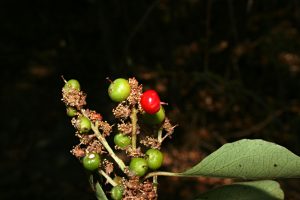
Scolopia zeyheri. Photo: Mark Hyde. Source: Flora of Zimbabwe.
Scolopia zeyheri. Most had huge spines and a distinctive orangy bark. I had not met the Scolopia “test” before — a waxy white line appears on the top surface of the leaf after it has been folded in half (the cuticle has been cracked) Strangely these trees appeared confined to this one small area. Rhamnus prinoides, a straggling shrub with bright shiny leaves, was growing amongst the Scolopias. Kim pointed out a feature I had not noticed before. There are two ranks of leaves, a lower layer of larger leaves and an upper layer of smaller leaves, often angled slightly backwards. On a horizontal branch this would allow for maximum utilization of sunlight. Another interesting find were some Ochnas – possibly 0. cyanophylle (later confirmed by Mr. Bob Drummond. Ed.). The grey bark was rough but did not have the rectangular fissures of O. schweinfurthiana, while the leaves were too big for O. puberula. I have some leaves at home and shall see if they turn ‘blue’ after a few days. Lower down the stream we came upon a grove of Catha edulis covered in early flower buds. Chewing the leaves was not a pleasant experience but I did think my lips were slightly numb as a result — not a worthwhile narcotic in this country, although apparently it is in Kenya. Rain stopped play at about lunch time. It would be lovely to follow the stream down to the Mazowe Dam in another time!
Tessa Ball
NYARUPINDA CATCHMENT February 1991
Christmas in Retrospect
There was a severe and widespread hailstorm on Christmas Day. December was more sorrowful than joyous for those who knew Dick Hicks and John Gordon. Now they are in surroundings which they cherished, a beautiful place for a pilgrimage of remembrance. Nyarupinda Catchment is such a place, Dedi (Mwonga) farm in particular, where in 1955 Liely Henriques and Neil Cardwell took up the Ayrshire Flying Club’s Piper Cub to scatter Alan Whitfield’s ashes over the land he loved and hoped to develop.
Candles are for remembrance too, here is news of successful Ximenia candles which were made recently for a sixty-fifth birthday party. Ximenia caffra represented “5” and X. americana represented “5”. Six burned brighter and longer than five because . . . . . . yes. . . . . . the former is Large Sour Plum and the latter is the smaller one. Fresh ripe fruit was collected at least three weeks before the candle was required, the shelled seed needed time to dry out while threaded horizontally on a 24cm length of wire of the thickness of a strong paper clip. The candle holder consisted of stiff clay packed into a Hind’s spice jar (minus lid and sprinkler) 6cm of wire is not threaded so that 6cm can be pushed into the holder. The remaining space allows a lighter to ignite the lowest oily seed to start the candle burning. Some melted wax was poured on top of the clay around the wire to give a neat finish. Finally the jar was covered with metallic paper. The kernels minus their tough coat have to be pre-bored carefully so that they do not break when put on the wire. The candle should be tested for dryness by trying to light it. When ready it flares brightly, long enough to read “The Herald”, all but the smallest print. These “green” candles were devised in the days when time was not money. Whilst the seeds burned, Torchwood was discussed; no one present at the party had ‘hands on‘ experience of burning any part of Balanites aeagyptica. No amount of hammering or using a vice will release the seed from its close-grained woody covering. Painstaking work with a fine hack-saw to cut off each end of the stone allowed the kernel to be pushed out of the central portion, this too should have time to dry so that it lights easily, only it did not light easily because we only had “Kudu” matches to light a candle to light the seed which rewarded us by burning quite brightly for more than ten minutes and gave off an agreeable roasting smell.
With reference to B. Goldsmith’s “Chirinda Forest” in Tree Life No. 130 “Borers, big and small break down wood remarkably quickly once the moisture content has dropped sufficiently”.
The big jobs are Bostrychid beetles, the small ones are Lyctid beetles, they are very well organised, some have a larval stage which may last a few months or several years tunneling in the wood, others have more than one generation annually. Borer grubs feed on the sapwood of hardwoods where they obtain moisture, sugar and starch, at first they go with the grain but later riddle the sapwood in all directions. The largest borers to come here arrived in two camp chairs from Zambia! Their huge Shot Holes were filled with insecticide and several adults emerged and got crunch treatment. Perish the thought of them living with us. Not long after this experience white dust began showering down and there were little piles of it on the floor. This was a great disappointment in the new house. Borers forced us to rearrange the furniture so as to avoid discomfort; as it is almost impossible to eradicate them, we hope that they will leave enough for etiquette which is sufficient to hold up the thatch. Repeated brushings with a solution of “Atlas AA” seems to have controlled some of them. A bulletin called “Powder Post and Other wood Borer Beetles which are Pests of Timber in ‘Rhodesia” was sent us by “Agricura”. It was prepared by D.J.W. Rose, B.Sc., A.R.C.S. who was Entomologist to the Federal Department of Agriculture. It is comprehensive and illustrated, it stresses the importance of obtaining ‘clean’ timber; hygiene begins in the plantation long before it goes to the mill or merchant. Heat treatment together with chemical protection is expensive but worthwhile in the long run. Timber with a high percentage of sapwood is suspect, e.g. time has proved that the Striped Mukwa doors in this house are ‘clean’. Much timber is sold in good faith, insect damage may not be noticeable until a year later.
The older order changeth and the foregoing is relevant to the redistribution of land necessitating renovation of derelict dwellings and construction of new ones.
Forest Research Centre Library at Highlands
FORMAT is the name of the Forestry Research Newsletter, in which they remind everyone that their library facilities are freely available to “accredited users”, this, surely, includes members of the Tree Society. The Borer bulletin may be in their collection. Another item eagerly sought by the writer is a textbook called “Timber, its Structure and Properties”, by H.E. Desch. It was written in simple language for Forestry students. It deals with wood sample analysis and gives details of preparing wood samples for a collection where space is limited.
Termite mounds are a source of interest all the year round, more so since Maureen Silva Jones has drawn attention to a paper by Bill Mitchell entitled “Ecological Effects of Termite Mounds.” This is compelling reading for everyone who enjoys roaming the wild. The author explains how the mound-building termites have contributed materially to the conservation of Africa. His revelations may change our attitudes towards these destructive insects. FORMAT December 1990 clarifies the mystique which surrounds the fungus gardens in the nests of wood—destroying termites by illustrating the delicate white termite mushroom and its thin pseudorrhiza arising from deep inside the termitarium. These fructifications are among the first to appear in the early rains, they are an African delicacy.
NYARUPINDA CATCHMENT (contd)
February Flowers
Aloe zebriga is the first, its buds were opening on Feb. 9th., growth of the peduncle is rapid. Single plants occur in the grass on stoney hillsides and in the fireguard along the boundary. Acacia gerrardii is beside roads and near vleis. Friesodielsia’s flowers do not look as if they could make a cluster of sausage-like fruits, have another look at these. Monkey Fingers is a popular name for this tree which grows in moist places in this catchment. Mnondo scents the afternoon air. Monkey Bread tree promises a gargantuan feast this season. A great event took place on the 29th January near the Mahobohobo on the steep bank below the veranda. It was unimportant that the male flowers of this tree were about to open because at tea time (p.m.) a flock of birds arrived; there was a sound of approaching rain before we saw the Swifts(?), they filled the air as they swooped down in ones and twos to feed on a thin column of flying ants rising from the soil. The speed and accuracy of this flock in the confined space between the slope, the tree and the nine foot fence, was remarkable. They circled this spot for at least ten minutes. It seemed quite risky to go outside but we did and were rewarded by seeing a frog catch the ants, the birds got those it missed. It is so fortunate that something news worthy happens every month.
Both species of Monotes, Allophylus, Rhus longipes,
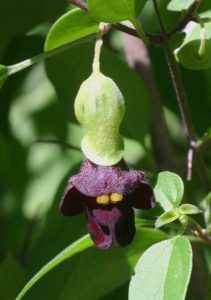
Tinnea rhodesica. Photo: Mark Hyde. Source: Flora of Zimbabwe.
Tinnea rhodesica, Heteromorphai the ground-hugging Ochna and a slender-stemmed shrubby one are flowering. Last month’s revelation about the Grewia /Adansonia relationship, could be confirmed by trimming the large white flowers of Grewia pachycalyx. February and March are good months for observing the tube formed by joined filaments in the flowers belonging to the family MALVACEAE, e.g. Azanza, Hibiscus spp. And some “weeds”; and in the following cultivated plants: Abutilon, cotton, ochra, rosella, mallow and hollyhock. The trio TILIACEAE, MALVACEAE, BOMBACEAE is followed by STERCULIACEAE which includes Dombeya, All these show variations on the staminal—column theme.
In Search of Something Different:
It has been worthwhile mooching about in places which have recently become sodden. A lofty Pleurostylia africana, hitherto unknown, close to the house, was advertised by swarms of insects. Its children were under the canopy and below them was a community of small white orchids. Near the dam where oxygen plant, Lagarosiphon, made life difficult for fisherman and wading birds, the scene has changed completely, grasses wave in the breeze and the bream are active at the water’s edge. On higher ground a Pin-tailed whydah bouncing along after a female made a detour to chase off a Pied Kingfisher which made for the safety of the open water. Elsewhere in sheltered places three different kinds of Ceropegia have been found. Some botanists are fascinated by this genus which is in ASCLEPIADACEAE, [the Milkweed Family).
Ayrshire members of the Tree Society look forward to meeting all of you in a few weeks time at the Gordon’s Farm, Darwendale.
Dickie Graves.
No news from the Natural History Museum in Bulawayo concerning the Miombo woodland spider and the freshwater sponges at the dam.
Dickie Graves
P.S. It would be of great interest in our tree mapping exercise if records were kept of exotic species which have become naturalised in the bush; If you come across any of the following species and consider that they are growing naturally in the area please add them to your card with comments if possible.
Toona ciliata Cedrila
Malia azedarach, Syringe Berry
Morus alba Mulberry
Jacaranda mimosifolia Jacaranda
Psidium guajava Guava
American Ash
Fraxinus americanus
Prunus cerasoides flowering cherry
FOOTNOTE:
Gill Masterson recently gave me her copy of Rudolf Marloth’s “Dictionary of Common Names of Plants” published in 1917. For me it is filled with wonderful memories like ‘kukumakranka’ (Gethyllis sgiralis), a small plant with narrow leaves shaped like a cork-screw that we hunted for on Rondebosch Common. And buchu (Barosma betulina) which was infused into brandy and drunk on our field trips into the Cedarberg and mountains of Clanwilliam. But I was most excited to find the famous withaak which is immortalized in Herman Charles Bosman’s stories told by Oom Schalk Lourens who lived in the Groot Marico of the western Transvaal. He was out on the far and of his farm, looking for strayed cattle: “I thought the cattle might be there because it is shady under those withaak trees, and there is soft grass that is very pleasant to sit on. After I had looked for the cattle for about an hour in this manner, sitting up against a tree-trunk, it occurred to me that I could look for them just as well, or perhaps even better, if I lay down flat. For even a child knows that cattle aren’t so small that you have got to get on to stilts and things to see them properly. . . . Overhead “a lonely aasvoel wheeled, circling slowly round and round without flapping his wings, and I knew that not even a calf could pass in any part of the sky between the tip of my toe and that aasvoel without my observing it immediately. What was more, I could go on lying there under the withaak — and looking for the cattle like that all day, if necessary.” Acacia polyacantha is known as the witdoring, but although doring and haak refer to thorns, this species does not grow in the Groot Marico. Marloth identifies the withaak as A. spirocarpoides, which is now A. tortilis., That makes sense, I find it a pity that names which enrich a cultural history are discarded in the name of efficiency.
Kim Damstra.
KIM DAMSTRA CHAIRMAN


